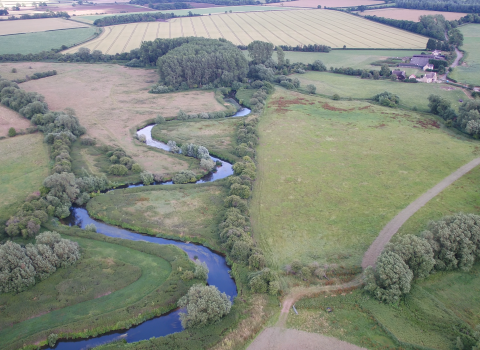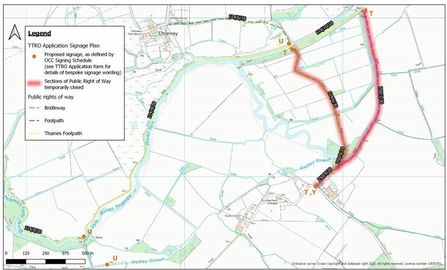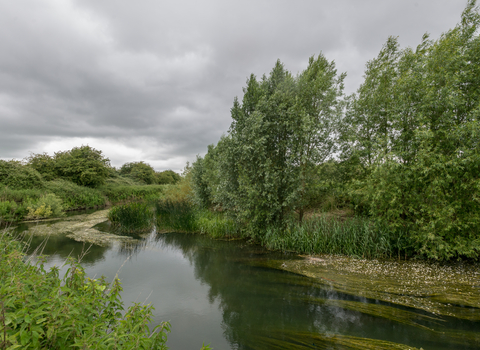Our new Wetland Restoration Project at Chimney Meadows is restoring precious habitats and making more space for nature.
Thanks to funding from RDPE Water Environment Grant, this exciting new partnership project will help fish move around Chimney Meadows, improve the connection between river and floodplain and revive and create new natural riverside wetland systems. These new and restored habitats will be homes for wildlife, as well as improving water quality in the Upper Thames area.
Project updates
Update June 2021
Oxfordshire County Council granted a temporary closure to certain rights of way to keep people safe during construction starting on Tuesday 1 June. There has been a delay in starting the works due to the wet weather in May so we have not actually had to close the bridleway yet. Our chosen Contractor, Five Rivers Environmental Contracting Ltd, has now started work on site. Our aim and that of our Contractor is to keep people safe through the construction phase of the project and only temporarily close public rights of way needed to keep people safe.
The Contractor will follow the conditions of the public rights of way closure and manage this through the summer, as necessary.
The Contractor will:
- Close access to Public Right of Way 250/9/10 (see map below) and the approach to it from the north along 114/6/30 (see map) on Wednesday 21 July.
- Erect barriers either side of the ford.
- Erect signage on the affected public rights of way including a sign at the T junction down to Duxford from Hinton Waldrist to warn visitors arriving by car.
- Maintain access for the properties with access off the bridleway towards the ford.
- The closure will be in effect 7 days per week and 24hrs a day from 21 July until the Duxford ford work is complete, which is expected to be by mid September.
Access to and along the footpath route between Duxford and Shifford Lock (Sections 250/9/20 and 250/1/30 on the map) is not yet affected but is likely to be temporarily closed during tree works on the northern side of Duxford ford in Duxford Plantation from Wednesday 1 Sept 2021.
This is in line with the conditions of the closure granted by Oxfordshire County with reference ‘TTRO (T8817) Temporary Footpath and Bridleway Closures, Hinton Waldrist, various Footpaths and Bridleways'.
Update May 2021
Duxford Ford - construction of a fish easement
BBOWT have planning permission to create a fish easement on the southern, downstream edge of Duxford Ford. This ‘submerged, rock pool step’ will help fish over Duxford Ford in times of low flow. You may start to see contractors in the area in May, preparing for the construction works, which are scheduled to take place through the summer, completing in September.
To enable the works to take place safely, a Temporary Traffic Regulation Order (TTRO) will be in place (24hr Mon-Fri) from 1 June 2021 for 6 months (until 1 Dec 2021), closing the bridleway across Duxford Ford and Chimney Island. In addition, there will be a period of 4-6 weeks mid-summer, when the bridleway over the ford will be closed continuously 24hrs a day and seven days a week.
Great Brook Ford – addition of baffles
Baffles (small wood, plastic or metal strips) are due to be fitted to the existing downstream face of the submerged concrete structure, leaving the structure surface unaltered. In low flow conditions, the baffles direct the flows to pass over one half of the submerged concrete structure, thereby slightly increasing the depth of flow, and aiding fish passage. The works at this location do not need planning permission.
Members of the public will be able to continue to use the footpath during the works, but the ford crossing will be controlled by the contractor during the works.
Duxford Ford – creation of native wet woodland:
The poplar trees at Duxford Ford were planted as a crop and are now over-mature and collapsing, causing a hazard. The project gives us the opportunity to safely remove the poplars and create a woodland for the future, comprising native broad-leaved trees which thrive naturally in such riverside locations. The plants will be protected by tree tubes which will help them establish more quickly and reduce the numbers eaten by deer. Some cut material will be used to create habitat piles and some lengths of timber will be left to create dead wood habitat on the ground.
As a wildlife charity we are very conscious of the value of trees in the landscape, for people and for wildlife. Knowing bats were present, we employed an ecologist to undertake detailed surveys of the bats and trees, to inform our plans. We will retain the main roosting/displaying area, other trees of importance (including some dead ones) and the weeping willows. As part of the mitigation we are planning to convert the pillbox into a bat hibernaculum, whilst retaining the heritage interest.
To help protect the new trees that we will be planting and to address issues of antisocial behaviour in the area (which were particularly bad last summer and caused considerable distress and inconvenience to Duxford residents), a new fence has been erected along the bridleway, in consultation with the Public Rights of Way Officer.
This work has been approved by the Forestry Commission. Felling of most of the poplars and subsequent replanting will take place from 1st September. Poplars south of the river will be felled as part of the fish easement works. Bats are a legally protected species and we are awaiting permission from Natural England to enable us to undertake the work.
Shifford Weir – creation of bypass channel and restoration of river and floodplain habitats
Planning permission has been granted to create a new ‘naturalised’ bypass channel, which will enable fish to access potentially good spawning grounds on the Duxford Loop, from the main channel of the River Thames and move around Shifford Weir. The bypass channel will be approximately 550m in length, help restore to floodplain habitats and boost biodiversity and provide optimum passage for slower swimming, course fish.
Update January 2021
Our planning applications have now been validated by the local planning authorities and are out for public consultation online until 10 and 11 February.
The Shifford Weir Bypass planning application should be determined by 9 March and Duxford Ford by 5 April. Should you wish to comment on the planning applications you can use the links and reference numbers below:
Shifford Weir fish bypass
Vale of White Horse (Lead Authority)
P20/V3225/FUL
Shifford Weir fish bypass
West Oxfordshire (only a small part of the scheme is in this authority’s area)
20/03409/FUL
Duxford ford fish easement
Vale of White Horse
P21/V0003/FUL
Update December 2020
Public Consultation
We held an online public consultation from 21 Oct – 8 Nov and had 10 responses. We have analysed these responses - thank you for your feedback. The key concerns and our response is outlined below
- Kayaks and canoes
A request was made to open up Duxford Loop for canoes and kayaks.While acknowledging that this would be a lovely area to paddle through, a decision has been made not to open it up further, as it is one of the few relatively undisturbed places on the River Thames and as such is a haven for wildlife such as otters and water voles. Much of the rest of the river is open to people to enjoy recreationally.
- Value for money
There was concern over about value for money and whether it was appropriate for government money to be spent on projects such as this, given so many people are currently losing their jobs as a result of the pandemic.This project is funded by the RDPE Water Environment Grant and funding was committed to this project before the pandemic. BBOWT started the application process in March 2018 and finally heard that the application was successful in December 2019.
- Access, seating and interpretation
There was a desire to open up access to the new bypass channel, increase access to the west of Chimney Meadows creating a circular walk from the car park to the Thames Path, have more hides, seating and interpretation boards.BBOWT’s nature reserves are managed firstly for wildlife and secondly for people to quietly enjoy and learn about the natural world. It is always a fine balance accommodating these needs, in addition to legal, logistical and other constraints.
At Chimney Meadows, to the north of the River Thames, BBOWT have created permissive paths linking public rights of way, creating circular paths of various lengths. These have, however, been routed away from the west of the nature reserve to keep this area undisturbed by people as it is where the curlew nest. It is however possible to get sight of these beautiful birds from the Thames Path. Duxford Old River similarly will not have open access, as it is logistically difficult to do so and we wish to keep this area undisturbed for wildlife. However, we do intend to run guided walks for people to see the land and the wetland restoration works, which can also be seen from a new raised bird hide that can be accessed from the Thames Path. We are considering whether to provide informal seating at Duxford Ford, and there will be a new interpretation board erected here and at various locations across the nature reserve.
- Flooding
There was concern as to whether the wetland restoration works would result in the flooding of local properties.A full and detailed Flood Risk Assessment has been prepared and was submitted with our planning application for the Shifford Weir Bypass Channel on 4 December. All planning application documents will be available on the Local Planning Authority’s planning portal once the planning application is validated. Overall, the hydraulic modelling indicates that the proposed development interventions have no to minimal impact on flood risk.
- Bats/Poplars
There were understandable concerns about removing the poplars and the impact of this work on the bat population, as well as other wildlife. As highlighted on the web site previously, the decision to clear the poplars has not been taken lightly. The trees were probably planted as a crop for the matchstick industry and never felled, as it became uneconomical. They are now reaching the end of their life and is evident, are starting to collapse. There are very few young trees growing to replace these trees, most likely because they are being eaten by deer. Ultimately if nothing is done, there will be no woodland and no homes for bats in the future.To avoid this situation, BBOWT intend to intervene and create an area of native wet woodland in place of the failing poplar plantation. Unfortunately, we cannot make it happen overnight or without changing the area.
BBOWT has been undertaking surveys of the bat population for many years as part of a wider programme of wildlife surveys across the nature reserve. Knowing bats were present, we employed a bat ecologist to undertake more detailed surveys of the poplars, so that we could understand which species were present and which trees/parts of trees the bats were using and in what way, to inform our plans. The surveys showed that whilst the bats were feeding throughout the plantation, their roosts and lekking (display) sites were in the north west of the plantation. We are going to retain these trees, along with a few others of importance. In addition, we will retain some of the trees as standing dead wood for woodpeckers, insects that depend on this habitat and future bat roost sites. Bats are a legally protected species and we cannot do any of the proposed works without permission from Natural England. An application for a bat licence is being prepared. As part of the mitigation we are planning to convert the pillbox into a bat hibernaculum, whilst retaining the heritage interest.
The cleared area will be replanted with native species of trees and shrubs to create woodland suited to the floodplain location. The plants will be protected by tree tubes which will help them establish more quickly and reduce the numbers eaten by deer. It is proposed that the following species will be planted: crack willow, alder, downy birch, pedunculate oak, crab apple, holly, elder, goat willow, grey sallow, hawthorn, guelder rose, blackthorn, alder buckthorn, purging buckthorn, osier willow, purple willow, dog rose, hazel. Some of the cut material will be used to create habitat piles and some lengths of timber will be left to create dead wood habitat on the ground. To help protect the new trees that we will be planting and to address issues of antisocial behaviour in the area (which were particularly bad last summer and caused considerable distress and inconvenience to Duxford residents), a new fence has been erected either side of the bridleway, in consultation with the Public Rights of Way Officer.
- Himalayan balsam
The need to control clear Himalayan balsam was raised and is acknowledged, hence including this work within the wetland restoration project.The intention was to start the programme of control in this area of the nature reserve in 2020. However, this did not happen because of the pandemic. BBOWT have been undertaking Himalayan balsam control at various places on Chimney Meadows for many years. Limited staff/volunteer time and resources has meant that we have had to target specific areas, which to date have been the Thames Path and National Nature Reserve. Our intention is now to address the problem in the Duxford area.
- Duxford Ford
Responses were in favour of the low-key solution proposed for helping fish over the ford deck in periods of low flow, which maintains the existing ford deck, over a more engineered option which had initially been considered.Finding a solution to helping fish move upstream through the Duxford Loop, during periods of low flow is challenging. Many different designs have been considered as there are many competing interests and pressures at this location and fish pass design is technical in nature. There is no risk that the right of access across the ford will be lost as legally BBOWT need to maintain the bridleway.
A planning application for a partial rock barrage fish easement downstream of the ford is in the process of being submitted to the Local Authority. It will take a little time for the application to be validated, but it is likely to be available to view early in the New Year.
Update July 2020
- Changes to the fords
We have started to investigate the feasibility of modifying the fords, exploring different possible options. Modification of these structures is technical in nature and the necessary permissions will be sought in due course. No decision has been made regarding the final design but we will update this page as the project progresses.A company called Yellow Sub will be on site 18 - 21 August to drill 4 cores out of the ford deck to ascertain the nature of the structure. They will be using a hand held mechanical drill. This will create some noise and dust while the work is carried out, and the water will look cloudy for a short time afterwards. We have informed them that there maybe people around and will put signs up before hand to inform the public that the work will be taking place.
- Tree works around Duxford ford
The poplar trees at Duxford Ford were planted as a crop, but were never felled and are now over-mature and collapsing, causing a hazard. The funding gives us the opportunity to safely remove the poplars and replant the area with native species of trees and shrubs which thrive in riverside locations, including willows, oak, birch and hawthorn. The young trees that are planted in place of the poplars will in time become wet woodland. By undertaking this work, we will be ensuring there will be woodland habitats for bats, birds and otters in the future. If nothing is done, the poplars will continue to collapse and there is not sufficient natural regeneration of trees and shrubs to replace these trees leading to the loss of woodland at this location.
As a wildlife charity we are very conscious of the value of trees in the landscape, for people and for wildlife. We have appointed an ecologist to work alongside the local Bat Group in order to ensure the work is carried out in a way to minimise impacts on bats, which we know use some of the trees. Bat surveys have been taking place over the last few years and recently more intensively, to understand the value of the plantation to bats and which areas are of most importance. These surveys will inform the number of poplars that can be removed and how they can be removed.The exact plan of felling and restocking has not yet been determined, but it is likely that a portion of the trees will be retained for the current bat population, whilst the remainder are removed in order to create space for the new replacement trees. The beautiful weeping willows, existing scrub and standing deadwood, which provides excellent habitat for insects and bats, would not be removed.
It was initially thought that the felling of poplars would be carried out in September 2020. Replanting of native woodland trees would then happen immediately after, before the end of September 2021 when the project is due to be complete. A felling licence from the Forestry Commission has been granted. Initial surveys have shown that we need to undertake further bat surveys in the autumn, so felling and restocking will take place later than planned, in winter 20/21 or possibly winter 21/22 depending on flooding.
- Removal of Himalayan Balsam
Small teams of volunteers have been pulling Himalayan Balsam out by hand to create space for native plants.



